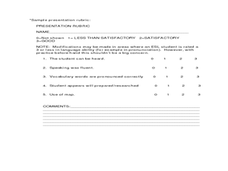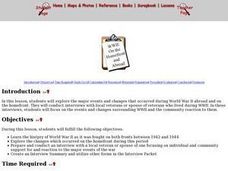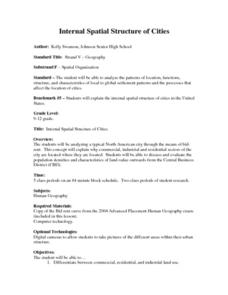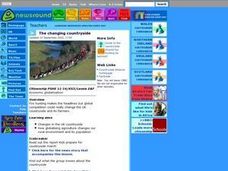Curated OER
Trial at the Turn of the Century
Learners examine and explore various aspects of change at the turn of the century including economic, political, civil and others. Students then locate and analyze various primary sources to write an essay that demonstrates their...
Curated OER
Reach For The Sky
Students consider alternative designs for a tall building and choose one of their designs to build. As a final step, they design and construct a model of a skyscraper.
Curated OER
Places in My World
Second graders explore where they are located on the globe. In this maps and globes lesson, 2nd graders use a map to show where they live and show the cardinal directions. Students identify characteristics of mountains, flat land,...
Curated OER
Once Upon A Time...
Students discuss elements of fairy tales, examine selected piece of Robert Harris' art, and compose fairy tales based on what they see and imagine. Students then view homes in Harris' artwork collection, create home in which they would...
Curated OER
Analyzing Civil War Pictorial Envelopes
Students explore the power of political messages contained in visual artifacts and examine the political messages conveyed by the illustrations that appeared on personal stationery used during the Civil War. They create and describe a...
Curated OER
Necessity is the Mother of Invention
Students research the Industrial Revolution. In this Industrial Revolution lesson plan, students research on the Internet, with books, magazines, fill out worksheets, and more to learn about inventions that were made out of necessity or...
Curated OER
Multicultural Issues and the Law: Gender and Race Based Schooling
Students examine the problems associated with gender based and race based education. In groups, they research the history of education and the laws that have changed education and impacted lives. They brainstorm a list of the positives...
Curated OER
Shoot for the Moon
Second graders distinguish the different phases of the moon. In this astronomy lesson, 2nd graders study the history of its discovery and myths about its origin. They simulate how the moon's surface is illuminated by the sun.
Curated OER
Working 9 to 5?
Students identify different industries of the Industrial Revolution in America through the following: text, web research and image analysis. They evaluate a poster created by their classmates using a Poster Analysis Form.
Curated OER
USH Test One
Eleventh graders write about one reason immigrants came to the United States in the late 1800's. They take a test that focuses upon past concepts and then an introduction is given by the teacher for the concepts of Imperialism and The...
Curated OER
A Walk in the Woods: The Legacy of the Haudenosaunee
Fourth graders explore folktales and legends to investigate the life and culture of the Haudenosaunee Indians. The stories and food of the six Nations are experienced as the lesson proceeds.
Curated OER
C¿¿sar Ch¿¿vez, Organizes the Farm Workers Association - Act I, Scene I "The House Meeting"
Eleventh graders analyze the development of federal civil and voting rights for minority groups. In groups, they discuss how Cesar Chavez organized the farm workers and the techniques he used when protesting. They define and practice...
Curated OER
WWII: On The Homefront and Abroad
Students explore World War II from the perspective of both the sides. They research the changes that occurred on the homefront during 1942-1944. Students prepare and conduct an interview with a local veteran or spouse of a veteran...
Curated OER
Got Park? Or if you build it, they will come!
High schoolers use GIS and GPS technology to evaluate, research, locate, and recommend where a new park should be located that benefit the community.
Curated OER
Post War Effects on Los Angeles
Eleventh graders research before and after pictures of a specific area of downtown Los Angeles. They create a poster depicting the changes.
Curated OER
Internal Spatial Structure of Cities
Students examine the internal spatial structure of cities. In groups, they analyze patterns of functions, structure and characteristics of settlement patterns. They also identify the population densities of land value of business...
Curated OER
Comparing Primary Sources from the Industrial Revolution
Tenth graders, in teams, analyze, evaluate and describe primary sources pertaining to industrialization at the turn of the century. They examine the sources and answer questions about each.
Curated OER
The American Indian Movement
Twelfth graders examine the civil rights movement of the Native Americans. They read the provided multicultural reading passage and answer the questions that follow. They chart which cultural groups fought for equal rights during the...
Curated OER
Building Relations
Students examine the relationships between particular landmarks and their home cities. They create posters illustrating the various connections and write scripts that could be used by tour guides.
Curated OER
What Is Smart Growth?
Students practice planning for the development of an area using the goals of Smart Growth as a guide. They analyze how regions can affect government policies. They role-play citizens who recommend how an area should be developed.
Curated OER
The New Immigrants
Students determine what lures immigrants to the Pittsburgh area. They conduct interviews to compare the experiences of new immigrants to the area to those of previous immigrants.
Curated OER
Internment of Japanese-Americans in Arkansas during WWII
Students identify the location, purpose, and details of the 2 Internment Camps in Arkansas for Japanese-Americans during WWII.
Curated OER
The Changing countryside
Students draw a poster showing the costs and benefits of opening up Britain's farmers to the global marketplace. They use a piece of A4 or A3 paper in landscape. Students draw a vertical line to split the page in two. On the left...
Curated OER
British Surnames Derived from Occupations or Professions
Students use guiding questions in order to provide a context for research within the lesson. They explain how certain British surnames derive from people's occupations, and recognize some of the more common names still prevalent.

























